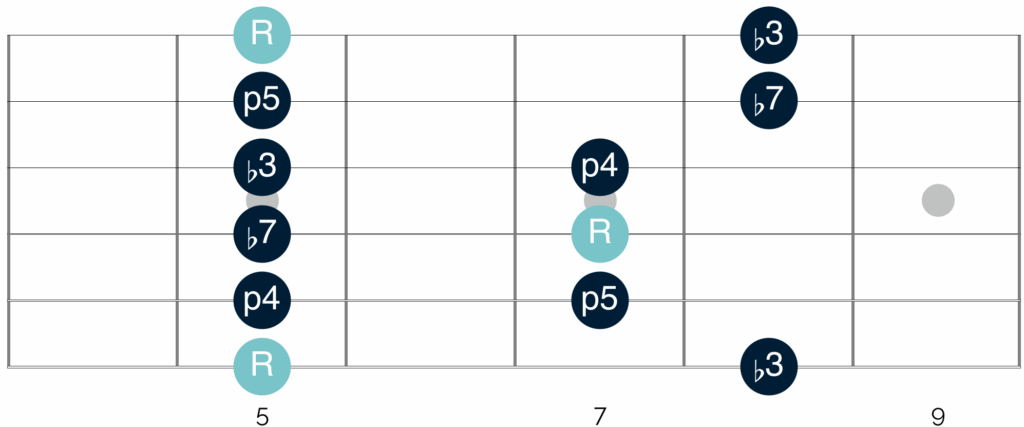To be able to consciously manipulate tension and resolution in your solos, it’s very useful to have some understanding of intervals.
This will help you to appreciate why certain notes create a sense of resolution, whilst others sound more open or tense.
The minor pentatonic scale
There are 5 notes in the minor pentatonic scale, and therefore 5 unique intervals in the scale. These are as follows:
- The tonic (1)
- The Minor Third (♭3)
- The Fourth (p4)
- The Fifth (p5)
- The Minor Seventh (♭7)
When we look at the first shape of the minor pentatonic scale (shown here in the key of A), these intervals appear in the following positions:

The tonic notes of A are highlighted in light blue, with all of the other intervals being marked by their respective numbers.
This specific diagram shows just the intervals present in the first shape of the scale. However, the minor pentatonic scale only contains these 5 notes.
In other words, if we shifted into another key or shape of the scale, the same intervals would appear – just in a different order or position on the fretboard.
For example, the intervals in the fourth shape of the A minor pentatonic scale appear as follows:

We would see the same intervals appearing in the second, third and fifth shapes.
Each of these intervals has a certain musical quality which impacts the way it sounds and function within a guitar solo.
At a broad level, we can place these intervals into one of two groups – those which create resolution and a sense of finality, and those which create tension or a sense of openness.
Resolution-creating intervals
The Tonic
- This creates the strongest sense of resolution
- It acts as a “musical home base” that you can treat as a safe note in your solos
- When you land here, it sounds complete and settled
- You can treat it as a musical full stop, to bring your phrases to a strong conclusion
The Fifth
- This is the second strongest resolution point in the minor pentatonic scale
- It creates a sense of resolution but there remains a certain openness in the sound
- It acts more like a musical comma than a full stop
Tension-creating intervals
The remaining notes of the scale (♭3, 4, ♭7) create tension and a sense of “forward motion”.
When these notes are targeted unintentionally (for example if you land on one of the notes expecting it to sound resolved) it will sound odd. It’s the musical equivalent of stopping in the middle of a sentence.
However, when you understand how to target these notes correctly, they open up many more options for your phrasing and will help you to create more interesting and varied blues guitar solos.
Understanding how to do this – and how to alter your approach for each of the intervals – will be the focus of the remaining lessons of this mini-course.
So when you’re ready, head over to the next lesson and let’s look at our first alternative for always resolving on the tonic note.
